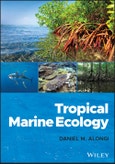No realm on Earth elicits thoughts of paradise more than the tropics. The tropical marine realm is special in myriad ways and for many reasons from seas of higher latitude, in housing iconic habitats such as coral reefs, snow white beaches, crystal clear waters, mangrove forests, extensive and rich seagrass meadows and expansive river deltas, such as the exemplar, the Amazon. But the tropics also has an even more complex side: tropical waters give rise to cyclones, hurricanes and typhoons, and unique oceanographic phenomena including the El Niño- Southern Oscillation which affects global climate patterns.
Tropical Marine Ecology documents the structure and function of tropical marine populations, communities, and ecosystems in relation to environmental factors including climate patterns and climate change, and patterns of oceanographic phenomena such as tides and currents and major oceanographic features, as well as chemical and geological drivers. The book focuses on estuarine, coastal, continental shelf and open ocean ecosystems. The first part of the book deals with the climate, physics, geology, and chemistry of the tropical marine environment. The second section focuses on the origins, diversity, biogeography, and the structure and distribution of tropical biota. The third part explores the rates and patterns of primary and secondary production, and their drivers, and the characteristics of pelagic and benthic food webs. The fourth part examines how humans are altering tropical ecosystems via unsustainable fisheries, the decline and loss of habitat and fragmentation, Further, pollution is altering an earth already in the throes of climate change.
Tropical Marine Ecology is an authoritative and comprehensive introduction to tropical marine ecology for advanced undergraduate and postgraduate students. It is also a rich resource and reference work for researchers and professional managers in marine science.
Table of Contents
Preface ix
1 Introduction 1
1.1 Definition of the Tropics 1
1.2 What Makes the Tropics Different? 2
References 6
Part 1 Physical Environment 7
2 Weather and Climate 9
2.1 Tropical Heat Engine 9
2.2 Tropical Winds and the Intertropical Convergence Zone (ITCZ) 11
2.3 Tropical Rainfall and Temperature Patterns 13
2.4 Monsoons 15
2.4.1 The Asian Monsoon 16
2.4.2 The Indo- Australian Monsoon 18
2.4.3 The African Monsoons 18
2.4.4 The South American Monsoon 20
2.5 Tropical Weather Systems 21
2.6 The El Niño- Southern Oscillation (ENSO), the Indian Ocean Dipole (IOD), the Madden- Julian Oscillation (MJO), and the Pacific Decadal Oscillation (PDO) 24
2.7 Climate Change: Physical Aspects 28
2.7.1 Rising Atmospheric CO 2 29
2.7.2 Ocean Acidification 30
2.7.3 Rising Temperatures, Increased Storms, Extreme Weather Events, and Changes in Precipitation 32
2.7.4 Changes in Ocean Circulation 33
2.7.5 Sea- Level Rise (SLR) 34
References 36
3 Tropical Marine Hydrosphere 40
3.1 Introduction 40
3.2 Large- Scale Circulation Patterns 40
3.3 Coastal Circulation 44
3.4 Estuarine Circulation 47
3.5 Coral Reef Hydrodynamics 52
3.6 Fluid Mechanics in Seagrass Meadows 54
3.7 Tides 56
References 57
4 Tropical Marine Geosphere 62
4.1 Major Sedimentary Patterns 62
4.2 Distribution of Major Habitat Types 66
4.3 Nutrients 74
4.4 Tropical River Loads, Plumes, and Shelf Margins 75
References 84
Part 2 Structure 87
5 Biogeography and Origins 89
5.1 Tropical Biogeography 89
5.2 The Coral Triangle 93
5.3 Origins Explained 97
5.4 Marine Ecoregions and Provinces 102
5.5 The Latitudinal Diversity Gradient 102
References 106
6 Populations and Communities 109
6.1 Introduction 109
6.2 Density Independence, Density Dependence, and Intraspecific Competition 110
6.3 Populations with Age Structure 114
6.4 Meta- populations 117
6.5 Interspecific Competition 120
6.6 Mutualism 130
6.7 Commensalism 135
6.8 Parasitism 136
6.9 Predation 138
6.10 Plant-Herbivore Interactions 150
6.11 Trophic Cascades 155
6.12 Facilitation Cascades 158
References 161
7 Ecosystems 175
7.1 Introduction 175
7.2 Rocky Shores 175
7.3 Sandy Beaches and Tidal Flats 178
7.4 Coastal Lagoons 186
7.5 Mangrove Forests 190
7.6 Seagrass Meadows 196
7.7 Coral Reefs 201
7.8 Continental Shelves 203
7.9 Open Ocean 216
References 227
Part 3 Function 237
8 Primary Production 239
8.1 Introduction 239
8.2 Sandy Beaches and Tidal Flats 240
8.3 Mangrove Forests 240
8.4 Seagrasses 251
8.5 Coral Reefs 260
8.6 Coastal Lagoons, Estuaries, and Tidal Waterways 267
8.7 Shelf Seas 273
8.8 Open Ocean 280
References 285
9 Secondary Production 298
9.1 Introduction 298
9.2 Heterotrophic Bacterioplankton 298
9.3 Zooplankton 301
9.4 Benthos 309
9.5 Fisheries 317
References 321
10 Food Webs and Carbon Fluxes 331
10.1 Introduction 331
10.2 Sandy Beaches and Tidal Flats 333
10.3 Rocky Intertidal Shores 340
10.4 Seagrass Meadows 343
10.5 Mangrove Forests 352
10.6 Coral Reefs 365
10.7 Estuaries and Coastal Lagoons 373
10.7.1 Food Webs 373
10.7.2 Carbon Dynamics 381
10.8 Coastal Bays and Continental Shelves 387
10.8.1 Trophic Dynamics 387
10.8.2 Carbon Cycling 390
10.9 Open Ocean 399
References 409
11 Nutrient Biogeochemistry 429
11.1 Introduction 429
11.2 Sandy Beaches, Tidal Flats, and Rocky Intertidal Shores 431
11.3 Seagrass Meadows 433
11.4 Mangrove Forests 437
11.4.1 N Cycling 437
11.4.2 P Cycling 446
11.5 Coral Reefs 448
11.6 Estuaries and Coastal Lagoons 460
11.7 Coastal Bays and Continental Shelves 464
11.8 Open Ocean 470
References 474
Part 4 Human Impacts 487
12 Pollution 489
12.1 Introduction 489
12.2 Hydrocarbons 490
12.3 Metals 496
12.4 Eutrophication 507
12.5 Pesticides and Industrial Organic Chemicals 518
12.6 Plastics and Other Marine Debris 529
12.7 Biological Pollution 538
12.7.1 Sewage and Microbial Diseases 538
12.7.2 Invasive Species 546
References 549
13 Climate Change 566
13.1 Introduction 566
13.2 Rising Temperatures, Increased Storms, Extreme Weather Events, and Changes in Precipitation 567
13.3 Sea- level Rise (SLR) 580
13.4 Rising Atmospheric CO 2 586
13.5 Ocean Acidification 588
13.6 Increasing Hypoxia 604
13.7 Impacts on Shelf and Oceanic Ecosystems and Fisheries 607
References 617
14 Habitat Destruction and Degradation 630
14.1 Introduction 630
14.2 Coral Reefs 630
14.3 Seagrass Meadows 635
14.4 Mangrove Forests 638
References 645
15 Epilogue 648
Index 659








